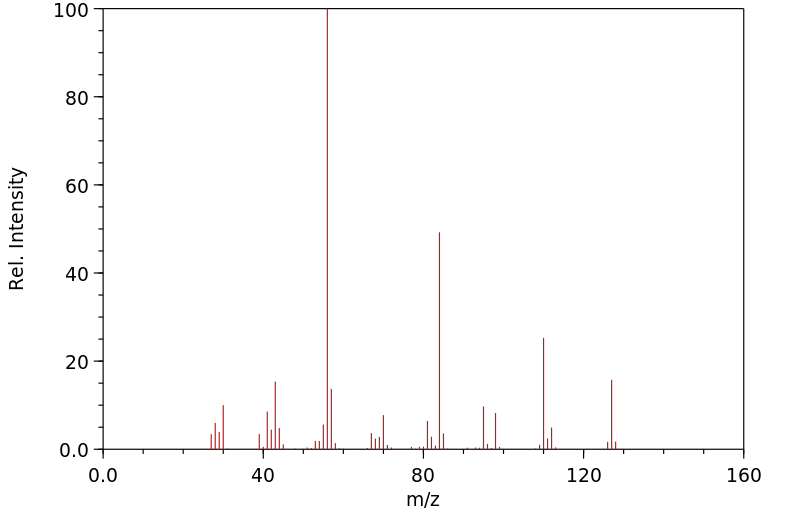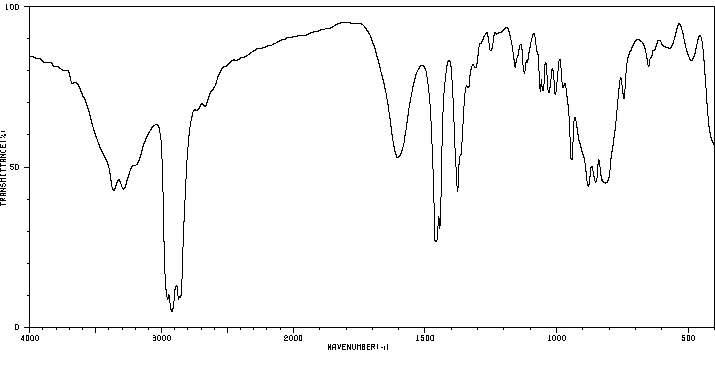2,3-二甲基环己胺 | 42195-92-6
中文名称
2,3-二甲基环己胺
中文别名
N-(1-芘基)马来酰亚胺
英文名称
2,3-dimethylcyclohexylamine
英文别名
2,3-dimethyl-cyclohexanamine;2,3-dimethyl-cyclohexylamine;2,3-dimethylcyclohexanamine;2.3-Dimethylcyclohexylamin;2,3-dimethylcyclohexan-1-amine
CAS
42195-92-6
化学式
C8H17N
mdl
MFCD00001493
分子量
127.23
InChiKey
LKWOOKWVBNSLGN-UHFFFAOYSA-N
BEILSTEIN
——
EINECS
——
-
物化性质
-
计算性质
-
ADMET
-
安全信息
-
SDS
-
制备方法与用途
-
上下游信息
-
文献信息
-
表征谱图
-
同类化合物
-
相关功能分类
-
相关结构分类
物化性质
-
熔点:-15°C (estimate)
-
沸点:158-160 °C(lit.)
-
密度:0.835 g/mL at 25 °C(lit.)
-
闪点:51 °C
-
物理描述:2,3-dimethylcyclohexyl amine appears as a water-white liquid. Less dense than water and slightly soluble in water. Hence floats on water. Very irritating to skin and eyes. Used to make other chemicals.
计算性质
-
辛醇/水分配系数(LogP):2
-
重原子数:9
-
可旋转键数:0
-
环数:1.0
-
sp3杂化的碳原子比例:1.0
-
拓扑面积:26
-
氢给体数:1
-
氢受体数:1
安全信息
-
危险等级:8
-
安全说明:S16,S25,S36/37/39,S45
-
危险类别码:R34,R10
-
海关编码:2921300090
-
包装等级:II
-
危险品运输编号:UN 2734
-
危险品标志:C
SDS
| Name: | 2 3-Dimethylcyclohexylamine mixture of isomers 99+% Material Safety Data Sheet |
| Synonym: | None known |
| CAS: | 42195-92-6 |
Synonym:None known
Section 2 - COMPOSITION, INFORMATION ON INGREDIENTS
| CAS# | Chemical Name | content | EINECS# |
| 42195-92-6 | 2,3-Dimethylcyclohexylamine | >99 | 255-704-2 |
Risk Phrases: 10 34
Section 3 - HAZARDS IDENTIFICATION
EMERGENCY OVERVIEW
Flammable. Causes burns.Corrosive.
Potential Health Effects
Eye:
Causes eye burns. May cause chemical conjunctivitis and corneal damage.
Skin:
Causes skin burns. May cause cyanosis of the extremities. May cause skin rash (in milder cases), and cold and clammy skin with cyanosis or pale color.
Ingestion:
May cause severe and permanent damage to the digestive tract. Causes gastrointestinal tract burns. May cause perforation of the digestive tract. Ingestion of large amounts may cause CNS depression. May cause systemic effects.
Inhalation:
Causes chemical burns to the respiratory tract. Inhalation may be fatal as a result of spasm, inflammation, edema of the larynx and bronchi, chemical pneumonitis and pulmonary edema. Aspiration may lead to pulmonary edema. Vapors may cause dizziness or suffocation.
May cause systemic effects. May cause burning sensation in the chest.
Chronic:
Effects may be delayed.
Section 4 - FIRST AID MEASURES
Eyes: Get medical aid immediately. Do NOT allow victim to rub eyes or keep eyes closed. Extensive irrigation with water is required (at least 30 minutes).
Skin:
Get medical aid immediately. Immediately flush skin with plenty of water for at least 15 minutes while removing contaminated clothing and shoes. Wash clothing before reuse. Destroy contaminated shoes.
Ingestion:
Do not induce vomiting. If victim is conscious and alert, give 2-4 cupfuls of milk or water. Never give anything by mouth to an unconscious person. Get medical aid immediately.
Inhalation:
Get medical aid immediately. Remove from exposure and move to fresh air immediately. If not breathing, give artificial respiration. If breathing is difficult, give oxygen. Do NOT use mouth-to-mouth resuscitation. If breathing has ceased apply artificial respiration using oxygen and a suitable mechanical device such as a bag and a mask.
Notes to Physician:
Section 5 - FIRE FIGHTING MEASURES
General Information:
As in any fire, wear a self-contained breathing apparatus in pressure-demand, MSHA/NIOSH (approved or equivalent), and full protective gear. Vapors may form an explosive mixture with air.
Vapors can travel to a source of ignition and flash back. During a fire, irritating and highly toxic gases may be generated by thermal decomposition or combustion. Will burn if involved in a fire. Use water spray to keep fire-exposed containers cool. Water may be ineffective. Material is lighter than water and a fire may be spread by the use of water. Containers may explode in the heat of a fire.
Flammable liquid and vapor. Vapors may be heavier than air. They can spread along the ground and collect in low or confined areas.
Extinguishing Media:
For small fires, use dry chemical, carbon dioxide, water spray or alcohol-resistant foam. For large fires, use water spray, fog, or alcohol-resistant foam. Use water spray to cool fire-exposed containers. Water may be ineffective. Do NOT use straight streams of water.
Section 6 - ACCIDENTAL RELEASE MEASURES
General Information: Use proper personal protective equipment as indicated in Section 8.
Spills/Leaks:
Absorb spill with inert material (e.g. vermiculite, sand or earth), then place in suitable container. Avoid runoff into storm sewers and ditches which lead to waterways. Clean up spills immediately, observing precautions in the Protective Equipment section. Remove all sources of ignition. Use a spark-proof tool. Provide ventilation. A vapor suppressing foam may be used to reduce vapors.
Section 7 - HANDLING and STORAGE
Handling:
Use only in a well-ventilated area. Ground and bond containers when transferring material. Use spark-proof tools and explosion proof equipment. Do not breathe dust, vapor, mist, or gas. Do not get in eyes, on skin, or on clothing. Empty containers retain product residue, (liquid and/or vapor), and can be dangerous. Keep away from heat, sparks and flame. Use only in a chemical fume hood. Discard contaminated shoes. Do not pressurize, cut, weld, braze, solder, drill, grind, or expose empty containers to heat, sparks or open flames.
Storage:
Keep away from heat, sparks, and flame. Keep away from sources of ignition. Store in a cool, dry place. Keep container closed when not in use. Store in a tightly closed container. Flammables-area.
Section 8 - EXPOSURE CONTROLS, PERSONAL PROTECTION
Engineering Controls:
Facilities storing or utilizing this material should be equipped with an eyewash facility and a safety shower. Use adequate general or local explosion-proof ventilation to keep airborne levels to acceptable levels.
Exposure Limits CAS# 42195-92-6: Personal Protective Equipment Eyes: Wear chemical splash goggles and face shield.
Skin:
Wear appropriate protective gloves to prevent skin exposure.
Clothing:
Wear appropriate protective clothing to prevent skin exposure.
Respirators:
A respiratory protection program that meets OSHA's 29 CFR 1910.134 and ANSI Z88.2 requirements or European Standard EN 149 must be followed whenever workplace conditions warrant respirator use.
Section 9 - PHYSICAL AND CHEMICAL PROPERTIES
Physical State: Clear liquid
Color: very slightly yellow
Odor: amine-like
pH: Not available.
Vapor Pressure: Not available.
Viscosity: Not available.
Boiling Point: 158 - 160 deg C
Freezing/Melting Point: Not available.
Autoignition Temperature: Not available.
Flash Point: 51 deg C ( 123.80 deg F)
Explosion Limits, lower: Not available.
Explosion Limits, upper: Not available.
Decomposition Temperature:
Solubility in water: Slightly soluble.
Specific Gravity/Density: .8350g/cm3
Molecular Formula: (CH3)2C6H9NH2
Molecular Weight: 127.23
Section 10 - STABILITY AND REACTIVITY
Chemical Stability:
Stable under normal temperatures and pressures.
Conditions to Avoid:
Ignition sources, excess heat.
Incompatibilities with Other Materials:
Strong oxidizing agents, strong acids.
Hazardous Decomposition Products:
Nitrogen oxides, carbon monoxide, carbon dioxide.
Hazardous Polymerization: Will not occur.
Section 11 - TOXICOLOGICAL INFORMATION
RTECS#:
CAS# 42195-92-6 unlisted.
LD50/LC50:
Not available.
Carcinogenicity:
2,3-Dimethylcyclohexylamine - Not listed by ACGIH, IARC, or NTP.
Section 12 - ECOLOGICAL INFORMATION
Section 13 - DISPOSAL CONSIDERATIONS
Dispose of in a manner consistent with federal, state, and local regulations.
Section 14 - TRANSPORT INFORMATION
IATA
Shipping Name: DIMETHYLCYCLOHEXYLAMINE
Hazard Class: 8 (3)
UN Number: 2264
Packing Group: II
IMO
Shipping Name: N,N-DIMETHYLCYCLOHEXYLAMINE
Hazard Class: 8
UN Number: 2264
Packing Group: II
RID/ADR
Shipping Name: DIMETHYLCYCLOHEXYLAMINE
Hazard Class: 8
UN Number: 2733
Packing group: II
Section 15 - REGULATORY INFORMATION
European/International Regulations
European Labeling in Accordance with EC Directives
Hazard Symbols: C
Risk Phrases:
R 10 Flammable.
R 34 Causes burns.
Safety Phrases:
S 16 Keep away from sources of ignition - No
smoking.
S 25 Avoid contact with eyes.
S 36/37/39 Wear suitable protective clothing, gloves
and eye/face protection.
S 45 In case of accident or if you feel unwell, seek
medical advice immediately (show the label where
possible).
WGK (Water Danger/Protection)
CAS# 42195-92-6: No information available.
Canada
None of the chemicals in this product are listed on the DSL/NDSL list.
CAS# 42195-92-6 is not listed on Canada's Ingredient Disclosure List.
US FEDERAL
TSCA
CAS# 42195-92-6 is not listed on the TSCA inventory.
It is for research and development use only.
SECTION 16 - ADDITIONAL INFORMATION
N/A
反应信息
-
作为反应物:参考文献:名称:酰基CoA:胆固醇O-酰基转移酶的新型抑制剂6,7-二氢-4H-吡唑并[1,5-a]吡咯并[3,4-d]嘧啶-5,8-二酮的合成及降胆固醇活性。摘要:描述了酶-CoA:胆固醇O-酰基转移酶的一系列新的6,7-二氢-4H-吡唑并[1,5-a]吡咯并[3,4-d]嘧啶-5,8-二酮抑制剂。发现这些衍生物中的许多是胆固醇喂养的大鼠中血清脂蛋白水平的有效调节剂。对最有效的类似物之一的进一步评估证实,它明显阻止了肠道中胆固醇的吸收。DOI:10.1021/jm00109a028
文献信息
-
[EN] AZOLE METHYLIDENE CYANIDE DERIVATIVES AND THEIR USE AS PROTEIN KINASE MODULATORS<br/>[FR] DERIVES DE CYANURE D'AZOLE METHYLIDENE ET LEUR UTILISATION COMME MODULATEURS DE PROTEINE KINASE申请人:APPLIED RESEARCH SYSTEMS公开号:WO2003106455A1公开(公告)日:2003-12-24The present invention is related to azole derivatives notably for use as pharmaceutically active compounds, as well as to pharmaceutical formulations containing such azole derivatives. Said azole derivatives are modulators of the protein kinase signalling pathways, particularly the one involving c-Jun N-terminal kinase and/or Glycogen Kinase Synthase 3. The present invention is furthermore related to novel azole derivatives as well as to methods of their preparation. X is O, S or NR0, with R0 being H or an unsubstituted or substituted C1 -C6 alkyl; A is 2-pyridyl, 3-pyridyl, 4-pyridyl, pyridazinyl, pyrimidinyl, pyrazinyl or triazinyl group.
-
Comestible compositions comprising high potency savory flavorants, and processes for producing them申请人:Senomyx, Inc.公开号:US08148536B2公开(公告)日:2012-04-03The present invention relates to the use of certain high potency savory (“umami”) taste modifiers, as savory flavoring agents and/or enhancers of monosodium glutamate, for the preparation of foods, beverages, and other comestible compositions, and to processes for preparing food flavorant compositions for use in the preparation of comestible food and drink.本发明涉及使用某些高效的鲜味("鲜味")味道调节剂,作为鲜味调味剂和/或谷氨酸钠的增强剂,用于制备食品、饮料和其他可食用组合物,并涉及用于制备用于制备可食用食品和饮料的食品香精组合物的过程。
-
Novel flavors, flavor modifiers, tastants, taste enhancers, umami or sweet tastants, and/or enhancers and use thereof申请人:Tachdjian Catherine公开号:US20050084506A1公开(公告)日:2005-04-21The present invention relates to the discovery that certain non-naturally occurring, non-peptide amide compounds and amide derivatives, such as oxalamides, ureas, and acrylamides, are useful flavor or taste modifiers, such as a flavoring or flavoring agents and flavor or taste enhancer, more particularly, savory (the “umami” taste of monosodium glutamate) or sweet taste modifiers,—savory or sweet flavoring agents and savory or sweet flavor enhancers, for food, beverages, and other comestible or orally administered medicinal products or compositions.
-
Design and synthesis of a novel DNA-encoded chemical library using Diels-Alder cycloadditions作者:Fabian Buller、Luca Mannocci、Yixin Zhang、Christoph E. Dumelin、Jörg Scheuermann、Dario NeriDOI:10.1016/j.bmcl.2008.07.038日期:2008.11DNA-encoded chemical libraries are increasingly being employed for the identification of binding molecules to protein targets of pharmaceutical relevance. Here, we describe the synthesis and characterization of a DNA-encoded chemical library, consisting of 4000 compounds generated by Diels-Alder cycloaddition reactions. The compounds were encoded with unique DNA fragments which were generated through
-
Scavenger assisted combinatorial process for preparing libraries of amides, carbamates and sulfonamides申请人:ELI LILLY AND COMPANY公开号:EP0825164A2公开(公告)日:1998-02-25This invention relates to a novel solution phase process for the preparation of amide, carbamate, and sulfonamide combinatorial libraries. These libraries have utility for drug discovery and are used to form wellplate components of novel assay kits.这项发明涉及一种用于制备酰胺、碳酸酯和磺酰胺组合库的新型溶液相过程。这些库在药物发现中具有实用价值,并用于形成新型检测套件的微孔板组件。
表征谱图
-
氢谱1HNMR
-
质谱MS
-
碳谱13CNMR
-
红外IR
-
拉曼Raman
-
峰位数据
-
峰位匹配
-
表征信息
同类化合物
(乙腈)二氯镍(II)
(R)-(-)-α-甲基组胺二氢溴化物
(N-(2-甲基丙-2-烯-1-基)乙烷-1,2-二胺)
(4-(苄氧基)-2-(哌啶-1-基)吡啶咪丁-5-基)硼酸
(11-巯基十一烷基)-,,-三甲基溴化铵
鼠立死
鹿花菌素
鲸蜡醇硫酸酯DEA盐
鲸蜡硬脂基二甲基氯化铵
鲸蜡基胺氢氟酸盐
鲸蜡基二甲胺盐酸盐
高苯丙氨醇
高箱鲀毒素
高氯酸5-(二甲氨基)-1-({(E)-[4-(二甲氨基)苯基]甲亚基}氨基)-2-甲基吡啶正离子
高氯酸2-氯-1-({(E)-[4-(二甲氨基)苯基]甲亚基}氨基)-6-甲基吡啶正离子
高氯酸2-(丙烯酰基氧基)-N,N,N-三甲基乙铵
马诺地尔
马来酸氢十八烷酯
马来酸噻吗洛尔EP杂质C
马来酸噻吗洛尔
马来酸倍他司汀
顺式环己烷-1,3-二胺盐酸盐
顺式氯化锆二乙腈
顺式吡咯烷-3,4-二醇盐酸盐
顺式双(3-甲氧基丙腈)二氯铂(II)
顺式3,4-二氟吡咯烷盐酸盐
顺式1-甲基环丙烷1,2-二腈
顺式-二氯-反式-二乙酸-氨-环己胺合铂
顺式-二抗坏血酸(外消旋-1,2-二氨基环己烷)铂(II)水合物
顺式-N,2-二甲基环己胺
顺式-4-甲氧基-环己胺盐酸盐
顺式-4-环己烯-1.2-二胺
顺式-4-氨基-2,2,2-三氟乙酸环己酯
顺式-3-氨基环丁烷甲腈盐酸盐
顺式-2-羟基甲基-1-甲基-1-环己胺
顺式-2-甲基环己胺
顺式-2-(苯基氨基)环己醇
顺式-2-(苯基氨基)环己醇
顺式-2-(氨基甲基)-1-苯基环丙烷羧酸盐酸盐
顺式-1,3-二氨基环戊烷
顺式-1,2-环戊烷二胺二盐酸盐
顺式-1,2-环戊烷二胺
顺式-1,2-环丁腈
顺式-1,2-双氨甲基环己烷
顺式--N,N'-二甲基-1,2-环己二胺
顺式-(R,S)-1,2-二氨基环己烷铂硫酸盐
顺式-(2-氨基-环戊基)-甲醇
顺-2-戊烯腈
顺-1,3-环己烷二胺
顺-1,3-双(氨甲基)环己烷








